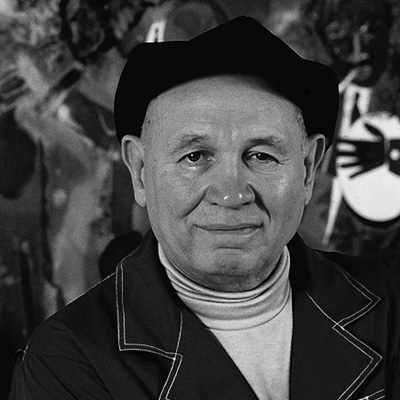Romare Bearden
 ...the function of the artist is to find ways of communicating, in sensible, sensuous terms, those experiences which to not find adequate expression in the daily round of living... Romare Bearden, May 1940
...the function of the artist is to find ways of communicating, in sensible, sensuous terms, those experiences which to not find adequate expression in the daily round of living... Romare Bearden, May 1940
(statement by Bearden for his solo exhibition organized by Addison Bates)
Romare Bearden is an American icon among twentieth century artists. During his early childhood, his parents relocated from his birthplace of Charlotte, North Carolina to Harlem, New York. During the Great Depression, Bearden studied at the Art Students League and began a career in public service as a social worker. He later studied philosophy and art history at the Sorbonne in Paris after serving during World War II. His Charlotte beginnings, Harlem childhood, formal education and travels to France were prominent influences. His mastery of European art principles and methods is evident not only in his art, but in many writings, including The Painter's Mind (co-authored with Carl Holty in 1981) where he explains the special relationships and techniques upon which his works are based.
Although primarily known for collage and printmaking, Bearden's artistic production included water colors, paintings, photomontage and even literature and award winning songs such as Seabreeze recorded by Billy Eckstine and Missus Santa Claus recorded by Leslie Uggams. His relationship with the Harlem Renaissance community influenced his ability to create the beauty he shared. In addition to being a cartoonist and a social realism painter, the prevailing visual art form in Harlem during the 1940s, he spent many of his early years as an abstract expressionist which is masterfully evidenced in his later figurative works.
In 1963 a number of prominent New York artists met in Bearden's studio where the formed the group "Spiral" to discuss ways to contribute to the Civil Rights Movement. Not only did Spiral result in Bearden's transition from broad Western aesthetic to African American themes in his art, but also to collage as his primary medium. He used his artwork to express the shared humanity of African American life and culture which was often rendered in both rural and urban settings. Bearden was sober in his perspective on U.S. racial relations by affirmatively employing his art to advance and challange race relations. Romare Bearden tailored the fabric of a people's twentieth century pathway from an anthropological muse.
Bearden, by any standard, is a great American artists who anchored many of his most recognized works in Black culture. It was only fitting that in 2003 his work was the subject of the first traveling exhibition of an African American artist that was organized by the National Gallery of Art in Washington, D.C. For more information on Romare Bearden, please reference the Bearden Foundation web site at http://www.beardenfoundation.org
WATCH VIDEO BELOW
WATCH VIDEO BELOW
Selected Exhibitions
Museum of Modern Art, NY, solo
The Studio Museum in Harlem, solo
Corcoran Gallery in Washington, D.C., solo
The National Gallery Of Art In Washington, DC, solo
Metropolitan Museum of Art, NY
Whitney Museum of American Art, NY
Boston Museum of Fine Arts, MA
Philadelphia Museum of Art, PA
SELECTED MUSEUM COLLECTIONS:
Metropolitan Museum of Art in New York
National Gallery of Art
Smithsonian Musem
Mint Museum, Charlotte, NC
Dallas Museum of Art, TX
SELECTED PUBLICATIONS:
Romare Bearden: His life and Art
By Myron Schwartzman
New York: Harry N. Abrams, Inc. 1990
The Art of Romare Bearden: The Prevalence of Ritual
By M. Bunch Washington
New York: Harry N. Abrams, Inc. 1973
The Art of Romare Bearden
By Ruth Fine
New York: Harry N. Abrams, Inc. 2003












